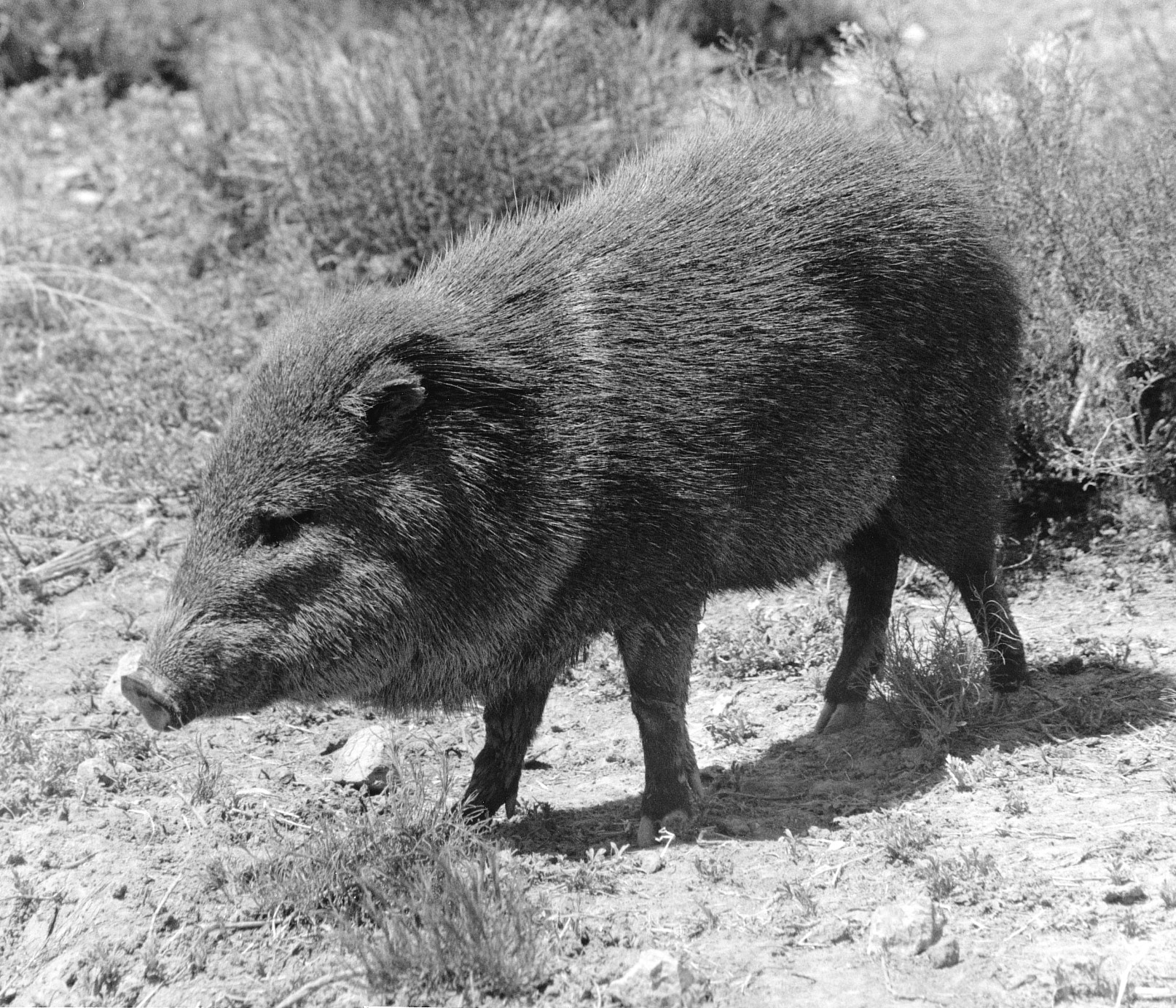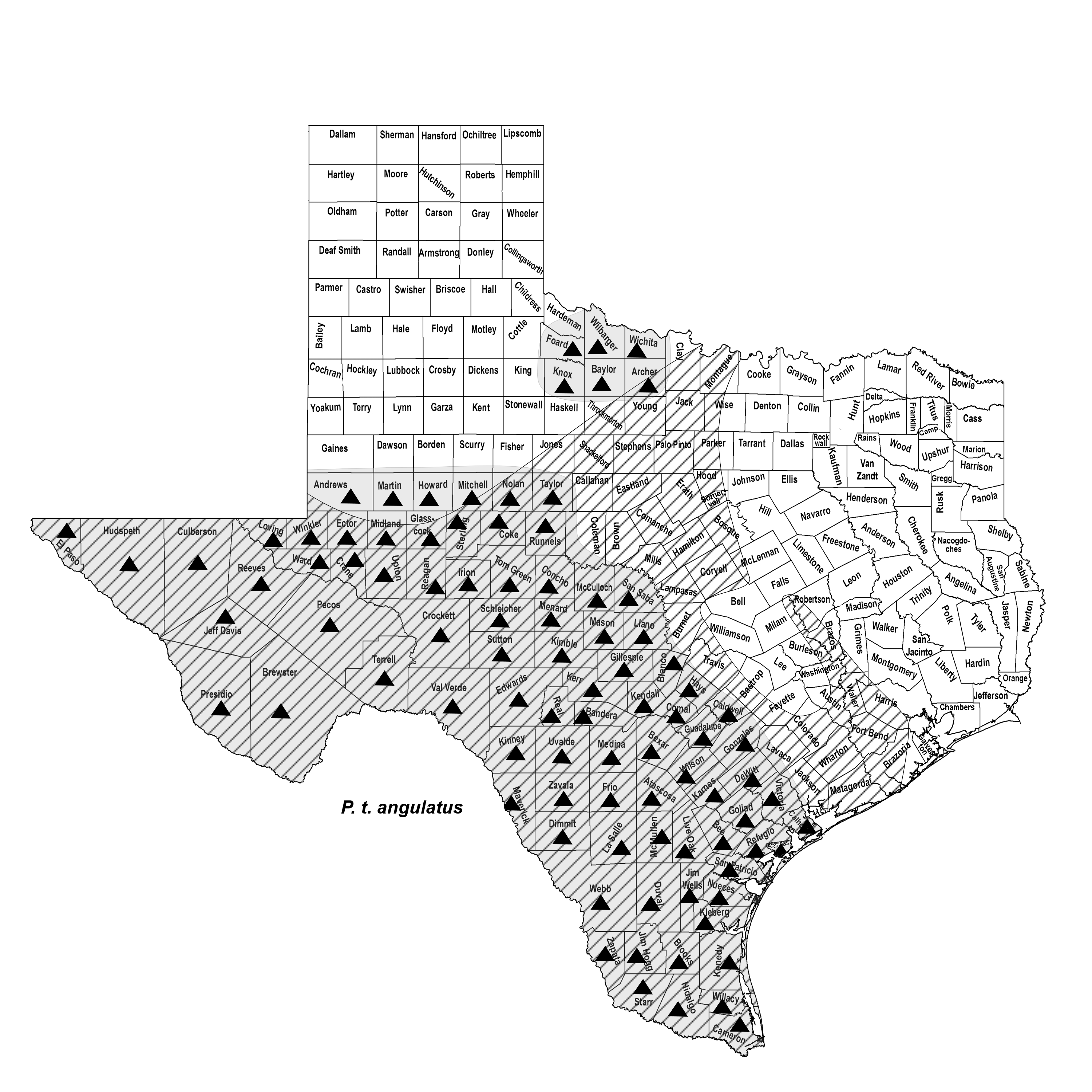COLLARED PECCARY
Pecari tajacu (Linnaeus 1758)
Order Artiodactyla : Family Tayassuidae
DESCRIPTION. These pig-like creatures are characterized by the presence of four hoofed toes on the front feet but only three on the hind feet (outer dewclaw absent); short, pig-like snout; crushing molars; nearly straight and dagger-like canines (tusks); harsh pelage with distinct mane from crown to rump; distinct musk gland on rump; two pairs of mammae, inguinal in position; distinct whitish collar across shoulder in adults, rest of upperparts grizzled black and grayish, with dark dorsal stripe; young reddish to yellowish brown, with black stripe down back. Averages for external measurements: total length, 870–1,016 mm; tail, 12 mm; hind foot, 210 mm; height at shoulder, 816 mm. Dental formula: I 2/3, C 1/1, Pm 3/3, M 3/3 × 2 = 38. Weight, 13–25 kg.

DISTRIBUTION. Formerly north to the Red River and east at least to the Brazos River Valley. Now restricted to western Texas and the brush country south of San Antonio. Introduced populations occur in several counties of north-central Texas.

SUBSPECIES. Pecari t. angulatus.
HABITS. In Texas, collared peccaries (often called javelinas) occupy the brushy semidesert
where prickly pear is a conspicuous part of the flora. They are commonly found in
dense thickets of prickly pear, chaparral, scrub oak, or guajillo; they also are found
in rocky canyons where caverns and hollows afford protection and in barren wastelands.
Peccaries are active mainly in early morning and late afternoon and often bed down
in dense brush or prickly pear thickets during the heat of midday.
Peccaries travel in groups ranging from a few animals to several dozen and have a
rather limited home range. In the brush country of South Texas, marked individuals
moved within home ranges varying in size from 73 to 225 ha (180–556 acres). Home ranges
of adjacent peccary herds may overlap slightly, but usually only one herd at a time
is found in this border. The boundaries of the home range are marked by scent emitted
from the conspicuous musk gland on the animal's rump, which also serves the individual
in keeping contact within the herd.
Legendary tales of the peccary have caused inexperienced hunters to kill them through fear rather than for either sport or food. Through exaggerated tales of the collared peccary's ferociousness, it has been charged that peccaries will kill or injure dogs and that they are a menace to deer hunters in the dense brush. It is true that encounters between peccaries and untrained dogs usually end with dead or crippled dogs, but it is also true that in these battles the dog is always the aggressor, and any animal will defend its life to the best of its ability when attacked. The peccary is absolutely harmless to the range, to livestock, and generally to humans.
Peccaries are chiefly herbivorous and feed on various cacti, especially prickly pear, mesquite beans, sotol, lechuguilla, and other succulent vegetation. In areas where prickly pear is abundant, peccaries seldom frequent water holes because the plants provide both food and water. Contrary to the habits of the common pig, peccaries rarely root in the ground but rather push around on the surface, even where the soil is very sandy and loose, turning up chunks of wood and cactus. Mast, fruits, and terrestrial insects also are eaten.
The collared peccary is the only wild ungulate of the western hemisphere with a year-round breeding season. The number of young is usually two, but litters range in size from one to five. The gestation period is 142–149 days. At birth, the young are reddish or yellowish in color and weigh about 500 g. They are able to follow the mother within a few days, at which time the family joins the rest of the herd. Young females attain sexual maturity in 33–34 weeks, young males in 46–47 weeks.
In Texas, the peccary was hunted commercially for its hide until 1939, when it was given the status of a game animal. Perhaps a far greater value is in its relationship to range vegetation, as peccaries are able to control (by eating) certain undesirable cacti present on overstocked rangeland.
POPULATION STATUS. Common. Although statewide population estimates for the collared peccary are not available, observations by TPWD personnel while conducting deer and pronghorn censuses provide estimates of relative population density in the various ecological regions they occupy. They are most numerous in the Trans-Pecos and South Texas Plains ecoregions. The 1999 Big Game Harvest Survey indicated that 17,730 peccary were harvested that year. Overall, populations are declining in many areas where habitat destruction and fragmentation have occurred and where large populations of feral pigs are known.
CONSERVATION STATUS. The IUCN lists the collared peccary as a species of least concern, and it does not appear on any federal or state lists of concerned species. However, this is a mammal that should be carefully monitored in the future.
REMARKS. In previous editions the scientific name of the collared peccary was given as Tayassu tajacu.
From The Mammals of Texas, Seventh Edition by David J. Schmidly and Robert D. Bradley, copyright © 1994, 2004, 2016. Courtesy of the University of Texas Press.
Natural Science Research Laboratory
-
Address
Museum of Texas Tech University, 3301 4th street, Lubbock, TX 79409 -
Phone
806.742.2486 -
Email
nsrl.museum@ttu.edu

